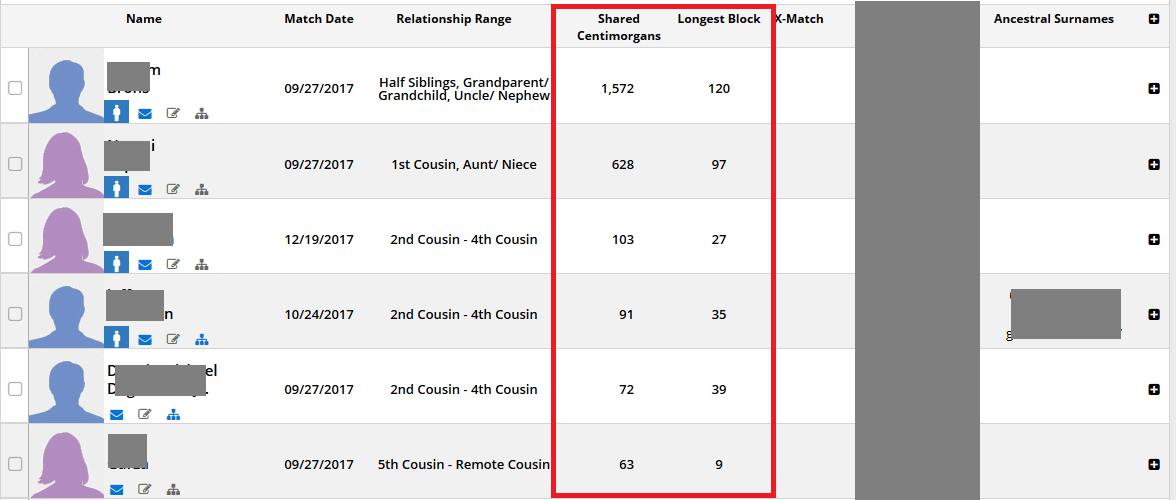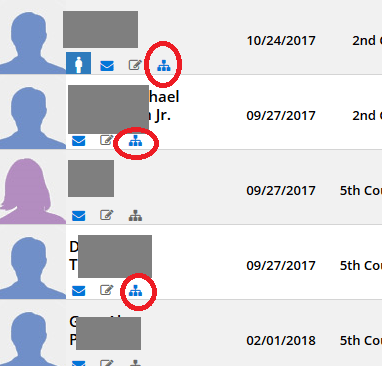One of the most exciting aspects of DNA testing is the extensive list of DNA matches that show up on your match list. If you scroll through your DNA matches, however, you will quickly realize that many times it is not immediately obvious how your DNA match is related to you. In this post, you will learn a few strategies for determining how you and your Family Tree DNA matches are connected.
What is your DNA match's name?
Most users on Family Tree DNA use their real name to make their account, and so this is the best first clue as to determining your relationship. When checking out their name, consider the following:
- What is their surname? Does it sound familiar? Do you have any family members, even extended ones, with this surname?
- If your DNA match is female, it is possible that they created their account using their married name?
How much DNA do you share with your match?
When you are looking at your DNA match list, you will see two columns labeled "Shared Centimorgans" and "Longest Block". These two columns provide some of the most valuable information for determining how far back your common ancestor is, and your exact relationship.
Centimorgans are the unit of measurement that geneticists use to describe the length of DNA segments. So, "Shared Centimorgans" is the total length of all of the matching DNA segments that you share with your match. The largest segment is the longest segment that you share together. The larger the segment, the closer the most recent common ancestor. The smaller the segment, the more distant, since DNA segments become smaller and more fragmented over the generations.
In the image below, you can see my relative's DNA results. The top match is his nephew, the second is his great-niece, and the next two are second cousins once-removed. You can see that the total amount of DNA that he shares with his nephew is high, and the segments are long. Segments quickly break up in just a few generations, and you can see that the largest segments he shares with the children of his second cousin are much, much smaller than the ones he shares with his nephew.

What is the estimated relationship with your DNA match?
In the column labeled "Relationship Range", Family Tree DNA provides you with an estimated relationship to your DNA match. This estimation is based on the total amount of shared segments, the size of the longest segment, and the total number of shared segments. The estimated relationship range is only an estimate. For any relationship other than a parent/child relationship, there is no way that any DNA testing company can provide you with an exact relationship. This is the reason that it is called an estimated relationship range, since for any given relationship type, there is a range of DNA typically shared between two people.
Even though the information in the Relationship Range column is just an estimate, it is still very helpful. If you consider the possible range of relationships you might have with your DNA match, you will know how far to back to look on your tree (and theirs) to find your connection.
If you have matches in common with your DNA match, it can provide important clues as to your relationship on FTDNA
Family Tree DNA has made some very helpful tools available to their customers. One of the most useful is the "in common with" function on the DNA match list. All you have to do is click the checkbox next to a DNA match, and then click the "in common with" function at the top of your list. FTDNA will then sort your matches and only display DNA matches that you share with the match that you checked off.
(Read about other neat ways to sort your FTDNA DNA matches)
When you share a DNA match with other matches, it can give you clues as to how you might be related. It isn't a guaranteed method, since you can actually be related to people in many ways, and your DNA match could be related to a shared match on a different line of his/her family, but it is a good starting point.
For example, let's pretend you have a first cousin match show up on FTDNA. If you have aunts and uncles from both sides of your family who have also tested, you can use the shared match tool to determine which line of the family they are on, or which line they are not on, based simply on who also matches them - and who doesn't.
The shared match tool is most useful for cousins who are 3rd cousins and closer, since the more distant the cousin, the less likely that all of your family members also share DNA with them. For reference, we will share DNA with 10% of our 3rd cousins, 50% of our 4th cousins, and will match few of our 5th-8th cousins. Additionally, the more distant the cousin, the less family lines we share in common with them, and them more likely it is that a shared DNA match is related to them and to us in different ways.
Do they have a family tree posted on the website?
Some people post their family trees on Family Tree DNA, and it's easy to spot which of your DNA matches have included a Family Tree on their profile. When you are scrolling through your DNA match list, you will see a tiny little family tree icon underneath your DNA match's name. If this family tree icon is show in blue, then your match has a family tree on the site. If it is grey, then either they have not posted a family tree yet. Some people don't know they can post or create a tree on Family Tree DNA, and others don't know their family history.
In the image below, you can see that three of my closest DNA matches have posted trees on the site - sweet! I can now look through their trees to see if I can spot a common ancestor or surname.

What kind of information is available on your DNA match's profile?
If you click on your DNA match's name from your match list, your match's profile will appear. On their profile, you can see their full name (as they have reported it to FTDNA), as well as their e-mail address, earliest known ancestors, ancestral surnames, and a biography, if they have chosen to post one.
I recommend doing a basic Google search, using the name of your match and/or their e-mail address. Many times (not all of the time), you might be able to determine a geographic location by the information that comes up in search results. You might also have good luck finding a family tree in this manner, since many people who do DNA tests are also very interested in genealogy. You can try doing a Google search for "DNA match name genealogy" (of course, put their name in along with genealogy). You never know what you will find!
Obviously, the point of all of this is to get a good look at their family tree, if possible. If you know enough about your tree, and they know enough about theirs (and have made it publicly available), you might be able to quickly spot your connection - any maybe even learn something about your family history that you didn't already know.
Build a family tree for your match to figure out how you are related
I know this might sound odd - why would you want to build a family tree for a DNA match that you don't even know? Don't you have enough work to do building your own family tree? Well, remember that your DNA match is family, and they fit into your tree somehow. The time you spend building out their family tree a little further just might be the key to discovering important information about your ancestors.
Many of my DNA matches have very small trees with only their parents and grandparents listed. While it doesn't seem like much, this is actually plenty of information for me to start building a family tree for them in order to spot where it might connect with mine. Once I have found the connection, I usually add those newly discovered family members to my own tree and sometimes contact my DNA match and let them known the information that I have learned. They are usually very friendly and interested to learn about their ancestors, too.
Don't rush into contact with your FTDNA matches
Some people are tempted to hurry into contact their DNA matches with a very vague "can you help me figure out how we are related"? Don't do this! I always recommend contacting a DNA match after you have spent a considerable amount of time trying to figure out your connection. In this manner, you can offer assistance to your DNA match and probably have a good idea where your connection lies before you attempt to make contact.
Conclusion
I hope that this post has helped give you a few ideas about how you can discover the connection between you and your DNA matches. This is my favorite part of DNA testing, and I hope that you find it enjoyable, too.
If you have any questions or comments, or would like to share a story about how you figured out your common ancestor with a DNA match, I would love to hear from you in the comments.
Thanks for stopping by!

